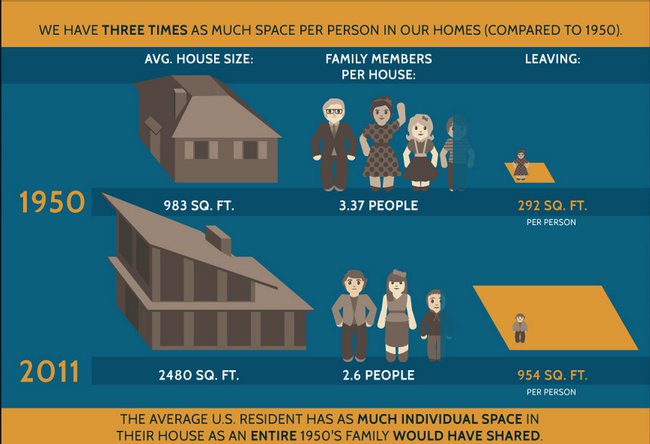I am having lunch today with Jonathan Miller of Miller Samuel, and that means the latest (and some of the craziest) NYC real estate updates.
In honor of this meal, have a look at the long term trend in home sizes in the US:

Source: Treehugger
I am having lunch today with Jonathan Miller of Miller Samuel, and that means the latest (and some of the craziest) NYC real estate updates.
In honor of this meal, have a look at the long term trend in home sizes in the US:

Source: Treehugger
Get subscriber-only insights and news delivered by Barry every two weeks.
Elizabeth Warren was way ahead of the curve on this, publishing about the two-income trap with bigger housing as one of the causes of struggling two-income households long before the housing bubble and financial crisis.
http://www.motherjones.com/politics/2004/11/two-income-trap
NAR and other organizations have been touting housing for a long time as an investment while Robert Shiller has been developing the data to show that typical housing increases with inflation over long periods of time. Its the bank-like leverage that provides returns, but that can cut both ways as people found out in the oil patch in the 1980s and nationally in the 2000s.
Thank Goodness that home prices can never go down!
We must surely be the richest people on the planet.
Kidding aside, along with the obvious idea that a home is (for the vast majority of people) a place to live in rather than an investment that one temporarily occupies, as the square footage scales up, so do the monthly utility bills (which keep rising even if one occupies the same home all their life).
Perhaps less really can be more.
This is ‘Murica where bigger is better.
Bigger mortgages.
Bigger taxes.
Bigger utility bills.
And, don’t you forget it.
That’s the size of my house, with only two people (used to be five) and four bedrooms. However, it seems I never have an open space to put my stuff on. ??????
BTW, yes in in 1950 our family of four lived in a 750 sq ft house and were glad to be out of the cold water flat.
Everyone wants their private space, even though most spend the majority of their time interacting with a portable or handheld computer while sitting on a chair and watching a big screen TV!
There’s actually a movement, now about 3+ years old, towards much smaller houses:
http://thetinylife.com/what-is-the-tiny-house-movement/
and google tiny house, and you’ll see an amazingly expansive amount of evidence to support this.
The future may see a significant trend towards smaller, less expensive homes.
….and this in today’s Wall Street Journal:
http://www.wsj.com/articles/little-getaway-homes-1423758817
Bigger house is needed to keep more stuff.
George Carlin: “Your house is just the place for your stuff”
https://www.youtube.com/watch?v=MvgN5gCuLac
Tiny house is too extreme for many (including me). Try this http://www.notsobighouse.com/
Another evolution is diminishing quality of construction over time. In 1950, a middle-class home would likely have lath and plaster walls as opposed to modern drywall. The former is generally more enduring and extremely more fire resistant, having some natural insulation qualities along with really superior sound proofing. It was replaced by drywall simply because the latter is cheaper and faster to install.
The irony is that nowadays, even in custom home construction, it’s almost impossible to opt for lath & plaster, The artisans who know how to do it right (we are talking high skilled labor) are down to a relative handful who usually are booked years in advance.
The same could be said about roofing, and to some extent about plumbing – although from personal experience I can attest that dealing with old cast iron pipes is a bitch (I’m talking about 90 year old pipes), but while the claim that PVC pipes are as durable is likely the case, they are in fact far noisier and of course are plastics made from oil as compared to recycled iron which is what the modern cast iron pipes are made of.
Given a choice and walked through the advantages, I think most would prefer iron – but they won’t have that choice, PVC is easier and cheaper, builders always go for those factors first.
Now windows and wiring are the best things about newer homes. Hands down a home built during the last decade is far more energy efficient and safer (in regards to electricity.
Still all in all: on a quality per foot basis, a middle class and up home from 1950 does seem to have much better “bones” than modern housing.
Two observations:
In our area, home sizes are getting smaller. Retirees building 4000 square foot homes are becoming dinosaurs. New retirees want a small, 1700-2000 square foot easy to manage property. They are currently figuring out that you don’t have to impress other north easterners who moved south because of warmer climes and less taxes (and nicer people) with a mansion just because one can afford it.
Home sizes come and go. Like interest rates.